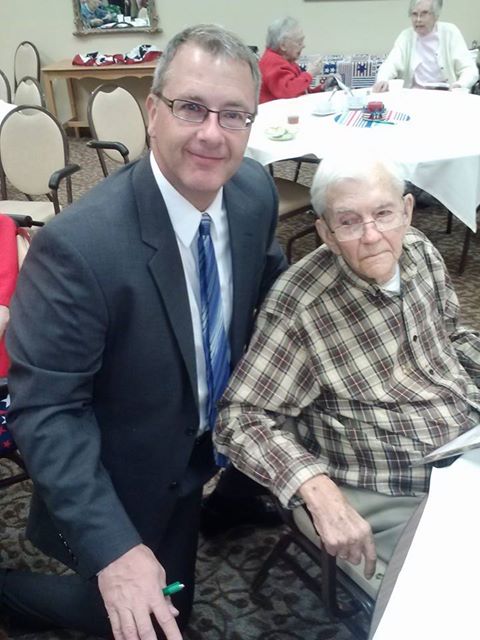You will learn about some very brave and inspirational people this week in the Tuesday newsletter. I was asked to speak on positive attitude on Veterans Day last Monday at a place known as The Waterford near where I am based in South Bend. Afterwards, I was blessed to learn the WWII stories of those at the event. Below is Bob Bob Battenburg.
Bob was at Normandy and Battle of the Bulge in World War II. He would crash land in a glider known as a flying coffin, and then carry a 35 pound pack of radio gear. Bob earned two Bronze Stars while in the 82nd airborne.
The flying coffin (picture below) was America’s first military stealth aircraft. The Waco CG-4A combat glider was powered only by the prevailing winds and the guts of the men who flew them like Bob.
At Normandy, Bob had to deal with the Germans being well prepared for a glider invasion. Beachheads were guarded by anti-aircraft guns. Likely landing zones were saturated with “Rommel’s asparagus” – a glider-smashing network of 10-foot poles wired together with explosives. Bob was able to survive his flying coffin trips and we are thankful for his service.
Below is a picture of Thair Best. What a story he shared with me.
Thair’s parents got a telegram in 1945 saying he was dead. I learned he enlisted in the Air Force the day after Pearl Harbor in 1941. He graduated from the Air Force Academy in 1944 and was immediately sent to fly combat missions. On his 45th mission Thair was shot down in Germany and became a prisoner of war. Thinking he was dead, the military sent a telegram to his parents and a funeral was held. They later learned he was alive. Decades later they found the crash site .. he went back and the 92 year old man now has metal from his plane in his room at the assisted living facilty.
Below is Duane Cable, still standing at age 98.
As a machinest 2nd class he watched when they put the flag up at Iwo Jima. “I never dreamed the picture they took of it would become so popular,” he told me.
The U.S. Marine Corps Memorial in D.C. honors that picture. Duane was on a nearby aircraft carrier and actually witnessed the flag being raised by five Marines and a Navy hospital corpsman that signaled the successful takeover of the island. The capture of Iwo Jima eventually led to the end of the war in 1945.
Like many, Duane had enrolled the day after Pearl Harbor. Now 98, Duane had four other brothers who survived the war. “The Lord has been good to us,” he told me.
The picture above, taken by Joe Rosenthal, is an inspirational story in itself. Rosenthal, the photographer, had been rejected by the Army because he had terrible eyesight, yet his picture of the flag-raising atop Mount Suribachi on Feb. 23, 1945, may be the most widely reproduced photo in American history. After the Army had turned him down because he could only see 1/20th as good as the average person, he enrolled with the U.S. Maritime Services and became a photographer.
Below is one of the most adorable pictures I have ever had the opportunity to be a part of! When I put it on my Facebook I had a zillion positive comments. That is Helen Rudolph.
She joined the Red Cross in 1945 as her way to serve. The picture I am holding is of her during those days. The Red Cross enrolled more than 104,000 nurses for military service, prepared 27 million packages for American and Allied prisoners of war, and shipped over 300,000 tons of supplies overseas. At the military’s request, the Red Cross also initiated a national blood program that collected 13.3 million pints of blood for use by the armed forces.
What a team effort!
In my inspirational talk to the veterans last week, I talked about having visited the USS Arizona site at Pearl Harbor. On Dec. 7, 1941 there were 1177 sailors and marines killed when the Japanese attacked and landed a direct hit on the Arizona.
In recent years many of the survivors have passed on due to natural causes or other reasons. Men like 93 year old Glenn Lane have asked that they be laid to rest within the Arizona, which you can still see under the shallow water at Pearl Harbor. Is there any better example of being a true team person than that?
A Navy diver placed an urn containing Lane’s ashes in a gun turret on the Arizona during a ceremony. Lane had been a seaplane radioman when bombs hit the Arizona. He was thrown into the water and survived.
I hope the stories of the men and women above inspire you as you head through this week.
–Charlie Adams is a 1985 graduate of Ole Miss and is a native of Oxford. He is also the author of 4 books on positive attitude and peak performance, including 2013′s “How to Build a Positive Attitude and KEEP the Darn Thing!!” and “Stoke the Fire Within.” His books and motivational keynotes and seminars are designed to make sure events reach their objectives and to help create winning cultures. Email him at:Charlie@stokethefirewithin.com.






